One Hour under the Monsoon Rain – Una hora bajo la lluvia del Monzón
[spanish below]
One hour under the Monsoon Rain
(by Omar Havana)
One afternoon as another in the “Kingdom of Wonder”, under the blinding sun of the low season of the city of Siem Reap, dozens of different voices entwined in the gateway of Ipads and sunglasses that is each day the center of the city of the temples of Angkor. This legendary city is the liar mirror where more than three million tourists annually draw conclusions about a country they visit, but they leave without knowing.
Only a couple of tens of minutes and kilometers Feeling the cool breeze of the giant lake Tonle Sap, and Cambodia appears in full splendor.
This is one of the places where you begin to know the reality of one of the fifteen countries of the world with the greatest economic growth in the last thirteen years, and still today where a third of the population lives on less than a dol- lar a day.
On the shores of the great lake, a small settlement of fishermen without fish hidden under posters of international aid projects serves as a clear example of the big lie that is hiding under the complicated system of the humanitarian business in Cambodia. Here, One hundred people living with the sky as a single ownership thinking about the next hour as their only hope. The dusty path that separates the two rows of houses that delineate serves as a play- ground to the dozens of children living with nothing in this forsaken place of Gods and Men. To one side the women bet the last riels in improvised bets of cards hiding aces between the toes; in the other, dogs and people share the ground-bed in a nap that makes the hours spend more quickly and amid, a sort of way where children, animals, women and men live the reality of a life without choices.
The sun blinding light of a few minutes ago start to hide behind the sound of what will be one of the first storms of the year. The sky darkens, the day becomes night and the street is empty. The first droplets begin to fall…
While the water is flooding the village, the frightened faces by the soundtrack of the afternoon look at the sky as searching for answers. Ten minutes of heavy rain and thunderstorms are followed by to the continuous fall of water when a little person covered in a pink and soaked towel crosses the horizon and a story begin, with life as a main and only star.
An existence where the first duty is the hard work of survival, that where it is understood that the rain is a gift impossible to despise. Under the pink wet towel emerge one hand that holds a dirty and torn small plastic bucket; suddenly bare hands appear from the shadows of each house, closing up to the pillars of bamboo in which they support their temporary homes in this village with no name. Drop by drop, smile a smile, the cubes start to fill in the makeshift channels that make up the cracks of the beams of the homes, “drinking water” says Chonny, one of the new tenants of the hut where we took refuge from the rain.

One of the children come back to the shelter of his home with the arrival of the first drops of rain under a huge umbrella
Under the watchful eye of their parents and grandparents only the bravest young people dare to leave the protection of their leaky roofs. Some, sham- poo in hand, hiding their bodies under soaked traditional and multitasks kra- mars which hides the timidity of the Cambodian culture. Others walk around under their “paper umbrellas” announcing relaxation sessions. Gradually, under the heavy rain the life is returning to the streets of the village, and the fear of the principle of the storm gives rise to a succession of scenes where the happiness of those who do not have nothing contrast with their fate of their daily existence.
In a country where children tend to be educated in the culture of the “one dollar, sir”, the flooded streets of any city are always the perfect pretext to unleash every child’s instincts and forget for an hour their reality where they are forced to behave like little adults seeking for survival, and in this place on the banks of the Tonle Sap was not going to be different. The flooded street serves as improvised water park where each child proudly shows the toys that they themselves have made with the garbage that is poured a few meters from their homes. Dressing only with their smile, they run and fall, they keep falling and getting up, and they run again and again, tumbling water at each other, laugh while enjoy one hour under the monsoon rain.
Almost sixty minutes after the sky announced the arrival of “drinking water” for the inhabitants of the village with no name, the clouds begin to open a raging horizon from which emerges a typical white and bright light that forced to leave the improvised refuge where three foreigners have witnessed scenes that not long ago they could see on any street of a developed world where rainwater and smiles of friends have been replaced by taps on video games pads or cellphone keyboards.
“Progress” in developed countries have gradually moved away children from this life lesson of the day-to-day life, away from the streets where those passing thirty-five years of age played once not many years ago. An hour in the rain of the monsoon, however, is the opportunity that every child expected in countries like Cambodia, where poverty that monetary wealth is replaced by the sense of living and of being a child, sixty minutes in the lives of the villagers have served as nameless rest to an existence where suffering leaves little room for happiness.
- A young boy fall into one of the enormous puddles full of mud of the lane while he was chased by other kids
Una hora bajo la lluvia del Monzón
(by Omar Havana )
Una tarde como otra en el llamado “país de las maravillas”, el cielo ciega las escasas miradas que pasean por las calles de la ciudad de Siem Reap. Decenas de voces se entremezclan en la pasarela de Ipads y gafas de
sol que es cada día el centro de la ciudad de los templos de Angkor. Esta mítica urbe es ese espejo mentiroso donde más de tres millones de turistas anualmente sacan conclusiones acerca de un país que visitan pero que abandonan sin conocer.

Not so many years ago the scene to see children running also in the streets of the developed countries was often seen
Solo un par de decenas de minutos y kilómetros sintiendo la agradable brisa del gigantesco lago Tonle Sap y Camboya se muestra en pleno es- plendor. Es ahí donde se empieza a conocer la realidad de uno de los quince países del Mundo con mayor crecimiento económico en los últimos trece años y donde hoy todavía un tercio de la población vive con menos de un dólar al día.
El sol cegador de hace unos minutos va dejado paso al sonido de lo que será una de las primeras tormentas del nuevo año. El cielo oscurece, el día se torna noche y la calle se vacía. Las primeras gotas empiezan a caer…
Mientras el agua va inundando la aldea, las miradas asustadas por la banda sonora de la tarde miran al cielo buscando respuestas. Diez minu- tos de fuerte lluvia dejan pasos al continuo caer de agua mientras una pequeña persona cubierta en una empapada toalla rosa cruza el hori- zonte encerrado en el objetivo de la cámara y empieza una historia diferente a la buscada.
Una historia donde la vida es la única protagonista. Una existencia donde el primer deber es el duro trabajo de la supervivencia, ese donde se en- tiende que la lluvia es un regalo imposible de despreciar. Bajo la mojada toalla rosa emergen unas manos que sostienen un sucio y destrozado pequeño cubo de plástico, de cada casa aparecen manos desnudas que se aproximan a los pilares de bambú en los que se apoyan los temporales hogares de esta aldea sin nombre. Gota a gota, sonrisa a sonrisa, los cu- bos empiezan a llenarse en los canales improvisados que forman las grietas de las vigas de los hogares “agua para beber” comenta Chonny, uno de los nuevos inquilinos de la chabola donde nos refugiamos de la lluvia.

One girl collects water from the rain in two plastic containers while filling a glass that she will use for shower
Bajo la atenta mirada de mayores, solo los más atrevidos jóvenes osan a salir de la protección de sus agujereados tejados. Unos, champú en mano, esconden sus cuerpos bajo empapados kramars en los que se esconde la timidez de la cultura camboyana. Otros, pasean bajo paraguas de papel que anuncian sesiones de relax. Poco a poco, bajo la fuerte lluvia la vida vuelve a las calles de la aldea, y el miedo del principio de la tormenta da lugar a un continuar de fotografías donde la felicidad de los que no tienen nada es la única protagonista.

A young boy fall into one of the enormous puddles full of mud of the lane while he was chased by other kids
En un país donde los niños suelen ser educados en la cultura del
“one dollar, sir”, las calles inundadas de cualquier ciudad son siempre el pretexto perfecto para dar rienda suelta a los instintos de todo niño y olvidarse por una hora del día a día donde son obligados a comportarse como pequeños adultos, y en este lugar en las orillas del Tonle Sap no iba a ser diferente. La calle cubierta de agua sirve como improvisado parque acuático donde cada uno prueba orgulloso los juguetes que ellos mismos han fabricado con la basura que se vierte a escasos metros de sus casas. Vestidos únicamente con su sonrisa, corren y se caen, se caen y se levantan, y vuelven a correr, se lanzan agua los unos a los otros, se ríen, sobre todo se ríen y disfrutan de la lluvia del monzón.
Casi sesenta minutos después de que el cielo anunciara la llegada del agua potable para los habitantes de la aldea sin nombre, las nubes em- piezan a abrir un enfurecido horizonte del que emerge una típica blanca y luminosa luz que obliga a dejar el improvisado refugio desde que tres extranjeros han sido testigos de escenas que no hace mucho tiempo se podía ver en cualquier calle de un mundo desarrollado donde el agua de la lluvia y las sonrisas de los amigos han sido sustituidos por pulsaciones sobre las teclas de chats o videojuegos.
El “progreso” en los países desarrollados ha ido apartando esta lección de vida del día a día de los niños occidentales, alejados de esas calles donde los que pasamos los treinta y cinco jugábamos a ser niños no hace muchos años. Una hora bajo la lluvia del monzón, sin embargo, es la oportunidad que todo niño espera en países como Camboya, esa donde la pobreza monetaria es sustituida por la riqueza del sentido de vivir y de ser niño, sesenta minutos que en las vidas de los habitantes de la aldea sin nombre han servido como descanso a una existencia donde el sufrimiento deja poco espacio a la felicidad.





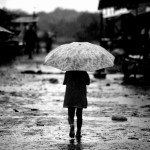
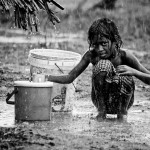
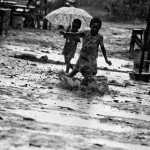
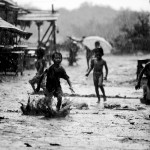
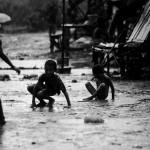
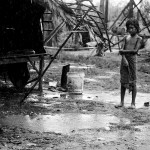
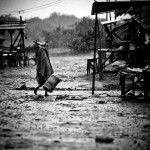
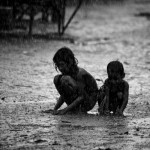
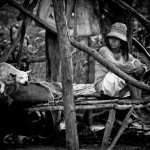
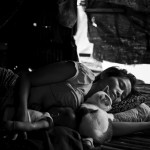

There are no comments
Add yours